Financial Analysis of Investment in New Machineries for STD Ltd
VerifiedAdded on 2023/06/10
|16
|3657
|389
Report
AI Summary
This report evaluates investment in new machinery for STD Ltd, comparing options G120 and Z125 using capital budgeting methods. It applies Accounting Rate of Return (ARR), payback period, Net Present Value (NPV), and Internal Rate of Return (IRR) to analyze the feasibility of each project. The report discusses the usefulness and limitations of each method, providing recommendations based on the computed figures. It also examines the risks associated with payback period and NPV, and the impact of IRR's reinvestment assumptions. The analysis concludes with a recommendation to accept option G120 based on the combined evaluation of the different capital investment appraisal measures. The report is a comprehensive guide for students studying financial analysis and capital budgeting.

Running head: FINANCIAL ANALYSIS
Financial analysis
Name of the Student
Name of the University
Author Note
Financial analysis
Name of the Student
Name of the University
Author Note
Paraphrase This Document
Need a fresh take? Get an instant paraphrase of this document with our AI Paraphraser
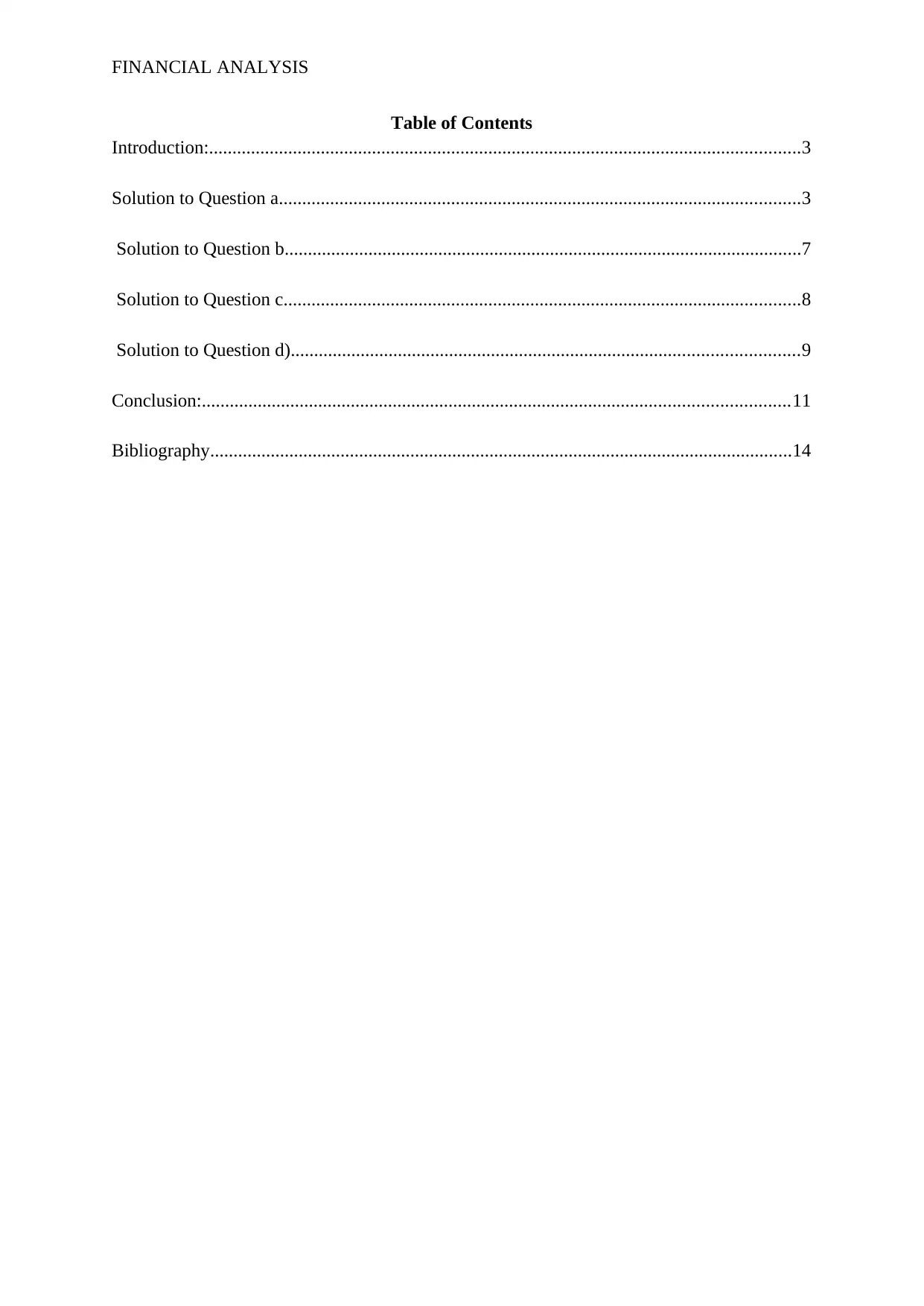
FINANCIAL ANALYSIS
Table of Contents
Introduction:...............................................................................................................................3
Solution to Question a................................................................................................................3
Solution to Question b...............................................................................................................7
Solution to Question c...............................................................................................................8
Solution to Question d).............................................................................................................9
Conclusion:..............................................................................................................................11
Bibliography.............................................................................................................................14
Table of Contents
Introduction:...............................................................................................................................3
Solution to Question a................................................................................................................3
Solution to Question b...............................................................................................................7
Solution to Question c...............................................................................................................8
Solution to Question d).............................................................................................................9
Conclusion:..............................................................................................................................11
Bibliography.............................................................................................................................14

FINANCIAL ANALYSIS
Introduction:
The report is prepared for evaluating the investment in a new piece of machineries by
STD Ltd. There are two options considered by organization that is G120 and Z125 and the
evaluation of project is done by the application of methods of capital budgeting. Different
mechanisms for analyzing feasibility of project applied by the business enterprise entails
Accounting rate of return (abbreviated as ARR), payback period, net present value (simply
referred to as NPV) along with internal rate of return (abbreviated as IRR). Usefulness of
different procedures of capital investment appraisal has been discussed in the report.
Requirement a)
The investment in a new piece of machinery by SD Ltd is evaluated by the application
of techniques of capital budgeting. There are two options available to company that is G120
option and Z125 option which requires significant amount of investment. Business
enterprises have implemented different modus operandi of capital budgeting that are hereby
explained herein below. The effectiveness of different measures of capital investment
appraisal is listed below:
Accounting rate of return (ARR):
Computation of ARR is done on average basis that helps in evaluating the expected
return earned from firm’s investment and the amount of profit generated by particular
investment option. It is a way that is used for compromising the earnings that is expected to
be generated from investment. Computation of accounting rate of return is done as annual
profit on average basis that is expected compared with the average amount of capital that is
invested over the life of investment project. The expected incremental net operating income is
divided by initial investment and thereby comparing it with the preferred rate of return set by
Introduction:
The report is prepared for evaluating the investment in a new piece of machineries by
STD Ltd. There are two options considered by organization that is G120 and Z125 and the
evaluation of project is done by the application of methods of capital budgeting. Different
mechanisms for analyzing feasibility of project applied by the business enterprise entails
Accounting rate of return (abbreviated as ARR), payback period, net present value (simply
referred to as NPV) along with internal rate of return (abbreviated as IRR). Usefulness of
different procedures of capital investment appraisal has been discussed in the report.
Requirement a)
The investment in a new piece of machinery by SD Ltd is evaluated by the application
of techniques of capital budgeting. There are two options available to company that is G120
option and Z125 option which requires significant amount of investment. Business
enterprises have implemented different modus operandi of capital budgeting that are hereby
explained herein below. The effectiveness of different measures of capital investment
appraisal is listed below:
Accounting rate of return (ARR):
Computation of ARR is done on average basis that helps in evaluating the expected
return earned from firm’s investment and the amount of profit generated by particular
investment option. It is a way that is used for compromising the earnings that is expected to
be generated from investment. Computation of accounting rate of return is done as annual
profit on average basis that is expected compared with the average amount of capital that is
invested over the life of investment project. The expected incremental net operating income is
divided by initial investment and thereby comparing it with the preferred rate of return set by
⊘ This is a preview!⊘
Do you want full access?
Subscribe today to unlock all pages.

Trusted by 1+ million students worldwide

FINANCIAL ANALYSIS
management (Ramiah et al. 2014). If the value of required rate of return is more than the
expected accounting rate of return, investment should be undertaken.
The ARR certainly has some drawbacks that by no means make it a perfect method
for evaluation of investment project. ARR does not necessarily consider and factor in the
notion of the time value of the considered money. Hence, any profit generated by project
would be completely offset by time value of considered money in event of high market
interest rate. The profitability of investment project is clearly overstated by accounting rate of
return because it does not incorporate time value of money (Graham et al. 2015).
Furthermore, the measure is not suitable when two projects are to be compared because there
are many factors that should be incorporated which is difficult to express quantitatively. Any
increased risk that arises in the forecast variability over a period of time is not accounted by
the measure. There also exists the possibility that the best alternatives of investment can be
misidentified using this tool. Therefore, accounting rate of return should be used along with
number of other tools.
Payback period
As suggested by Nuhu et al. (2016), the capital budgeting technique of payback
period is a particular way of analysis that can be applied for ascertainment of the time
required to cover up and get back the initial amount invested in a specific project. It is the
time taken by cash flow generated by project to pay back the initial amount in the project.
Payback period helps in minimizing the risks attributable to investment project and helps in
addressing management concern regarding liquidity. Payback period is used by organization
as a measure of project liquidity instead of profitability of project (Focacci 2017).
management (Ramiah et al. 2014). If the value of required rate of return is more than the
expected accounting rate of return, investment should be undertaken.
The ARR certainly has some drawbacks that by no means make it a perfect method
for evaluation of investment project. ARR does not necessarily consider and factor in the
notion of the time value of the considered money. Hence, any profit generated by project
would be completely offset by time value of considered money in event of high market
interest rate. The profitability of investment project is clearly overstated by accounting rate of
return because it does not incorporate time value of money (Graham et al. 2015).
Furthermore, the measure is not suitable when two projects are to be compared because there
are many factors that should be incorporated which is difficult to express quantitatively. Any
increased risk that arises in the forecast variability over a period of time is not accounted by
the measure. There also exists the possibility that the best alternatives of investment can be
misidentified using this tool. Therefore, accounting rate of return should be used along with
number of other tools.
Payback period
As suggested by Nuhu et al. (2016), the capital budgeting technique of payback
period is a particular way of analysis that can be applied for ascertainment of the time
required to cover up and get back the initial amount invested in a specific project. It is the
time taken by cash flow generated by project to pay back the initial amount in the project.
Payback period helps in minimizing the risks attributable to investment project and helps in
addressing management concern regarding liquidity. Payback period is used by organization
as a measure of project liquidity instead of profitability of project (Focacci 2017).
Paraphrase This Document
Need a fresh take? Get an instant paraphrase of this document with our AI Paraphraser
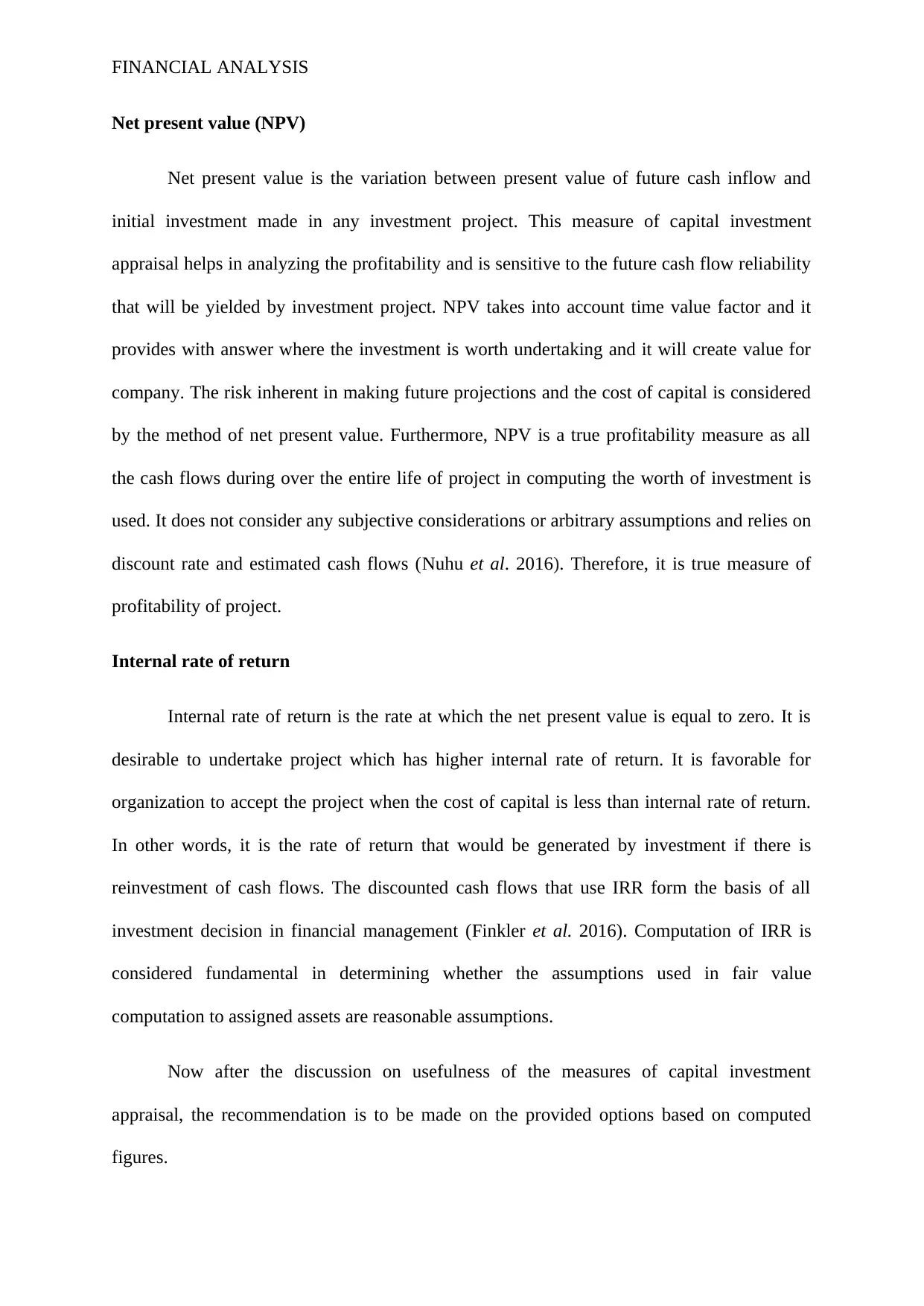
FINANCIAL ANALYSIS
Net present value (NPV)
Net present value is the variation between present value of future cash inflow and
initial investment made in any investment project. This measure of capital investment
appraisal helps in analyzing the profitability and is sensitive to the future cash flow reliability
that will be yielded by investment project. NPV takes into account time value factor and it
provides with answer where the investment is worth undertaking and it will create value for
company. The risk inherent in making future projections and the cost of capital is considered
by the method of net present value. Furthermore, NPV is a true profitability measure as all
the cash flows during over the entire life of project in computing the worth of investment is
used. It does not consider any subjective considerations or arbitrary assumptions and relies on
discount rate and estimated cash flows (Nuhu et al. 2016). Therefore, it is true measure of
profitability of project.
Internal rate of return
Internal rate of return is the rate at which the net present value is equal to zero. It is
desirable to undertake project which has higher internal rate of return. It is favorable for
organization to accept the project when the cost of capital is less than internal rate of return.
In other words, it is the rate of return that would be generated by investment if there is
reinvestment of cash flows. The discounted cash flows that use IRR form the basis of all
investment decision in financial management (Finkler et al. 2016). Computation of IRR is
considered fundamental in determining whether the assumptions used in fair value
computation to assigned assets are reasonable assumptions.
Now after the discussion on usefulness of the measures of capital investment
appraisal, the recommendation is to be made on the provided options based on computed
figures.
Net present value (NPV)
Net present value is the variation between present value of future cash inflow and
initial investment made in any investment project. This measure of capital investment
appraisal helps in analyzing the profitability and is sensitive to the future cash flow reliability
that will be yielded by investment project. NPV takes into account time value factor and it
provides with answer where the investment is worth undertaking and it will create value for
company. The risk inherent in making future projections and the cost of capital is considered
by the method of net present value. Furthermore, NPV is a true profitability measure as all
the cash flows during over the entire life of project in computing the worth of investment is
used. It does not consider any subjective considerations or arbitrary assumptions and relies on
discount rate and estimated cash flows (Nuhu et al. 2016). Therefore, it is true measure of
profitability of project.
Internal rate of return
Internal rate of return is the rate at which the net present value is equal to zero. It is
desirable to undertake project which has higher internal rate of return. It is favorable for
organization to accept the project when the cost of capital is less than internal rate of return.
In other words, it is the rate of return that would be generated by investment if there is
reinvestment of cash flows. The discounted cash flows that use IRR form the basis of all
investment decision in financial management (Finkler et al. 2016). Computation of IRR is
considered fundamental in determining whether the assumptions used in fair value
computation to assigned assets are reasonable assumptions.
Now after the discussion on usefulness of the measures of capital investment
appraisal, the recommendation is to be made on the provided options based on computed
figures.
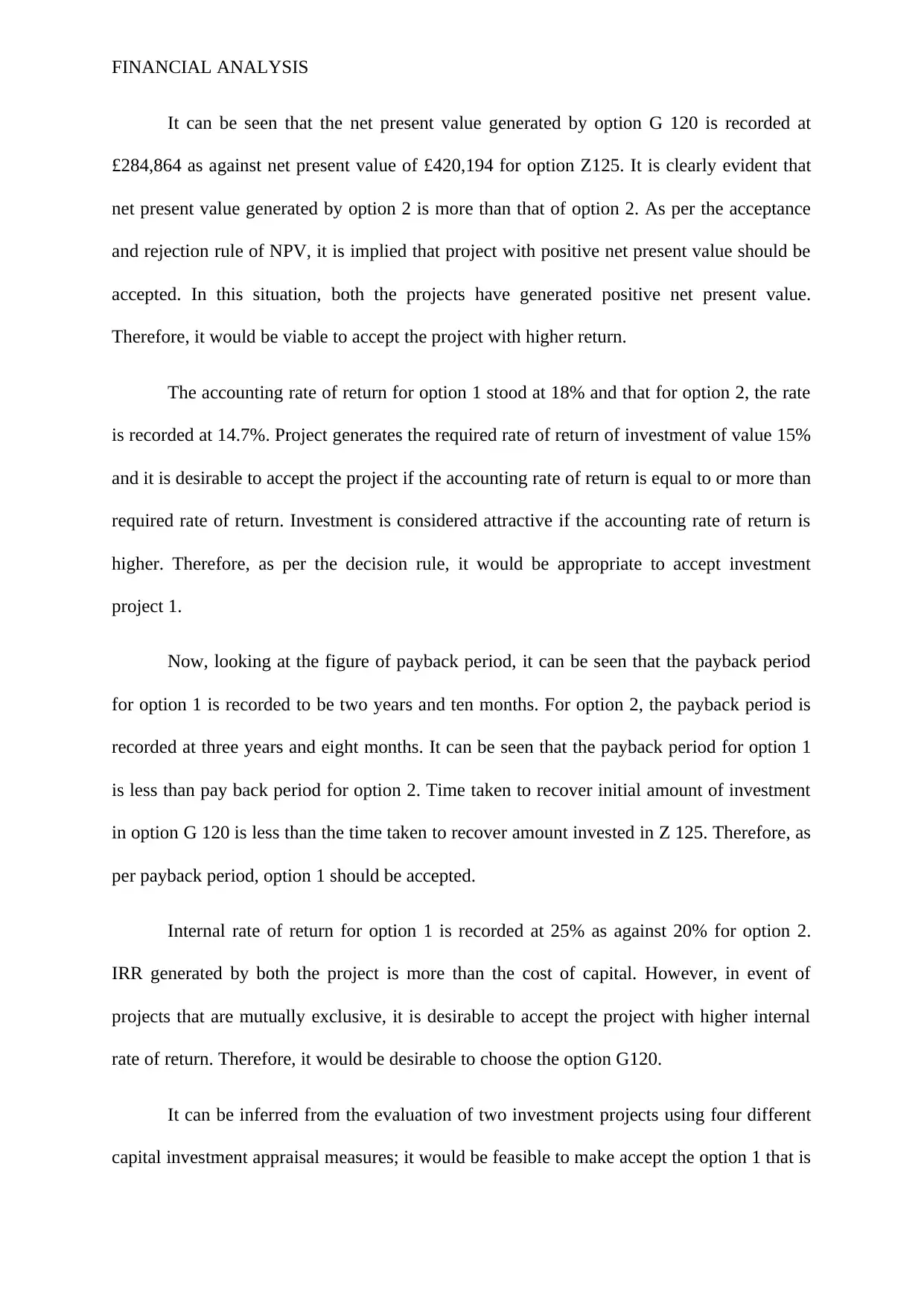
FINANCIAL ANALYSIS
It can be seen that the net present value generated by option G 120 is recorded at
£284,864 as against net present value of £420,194 for option Z125. It is clearly evident that
net present value generated by option 2 is more than that of option 2. As per the acceptance
and rejection rule of NPV, it is implied that project with positive net present value should be
accepted. In this situation, both the projects have generated positive net present value.
Therefore, it would be viable to accept the project with higher return.
The accounting rate of return for option 1 stood at 18% and that for option 2, the rate
is recorded at 14.7%. Project generates the required rate of return of investment of value 15%
and it is desirable to accept the project if the accounting rate of return is equal to or more than
required rate of return. Investment is considered attractive if the accounting rate of return is
higher. Therefore, as per the decision rule, it would be appropriate to accept investment
project 1.
Now, looking at the figure of payback period, it can be seen that the payback period
for option 1 is recorded to be two years and ten months. For option 2, the payback period is
recorded at three years and eight months. It can be seen that the payback period for option 1
is less than pay back period for option 2. Time taken to recover initial amount of investment
in option G 120 is less than the time taken to recover amount invested in Z 125. Therefore, as
per payback period, option 1 should be accepted.
Internal rate of return for option 1 is recorded at 25% as against 20% for option 2.
IRR generated by both the project is more than the cost of capital. However, in event of
projects that are mutually exclusive, it is desirable to accept the project with higher internal
rate of return. Therefore, it would be desirable to choose the option G120.
It can be inferred from the evaluation of two investment projects using four different
capital investment appraisal measures; it would be feasible to make accept the option 1 that is
It can be seen that the net present value generated by option G 120 is recorded at
£284,864 as against net present value of £420,194 for option Z125. It is clearly evident that
net present value generated by option 2 is more than that of option 2. As per the acceptance
and rejection rule of NPV, it is implied that project with positive net present value should be
accepted. In this situation, both the projects have generated positive net present value.
Therefore, it would be viable to accept the project with higher return.
The accounting rate of return for option 1 stood at 18% and that for option 2, the rate
is recorded at 14.7%. Project generates the required rate of return of investment of value 15%
and it is desirable to accept the project if the accounting rate of return is equal to or more than
required rate of return. Investment is considered attractive if the accounting rate of return is
higher. Therefore, as per the decision rule, it would be appropriate to accept investment
project 1.
Now, looking at the figure of payback period, it can be seen that the payback period
for option 1 is recorded to be two years and ten months. For option 2, the payback period is
recorded at three years and eight months. It can be seen that the payback period for option 1
is less than pay back period for option 2. Time taken to recover initial amount of investment
in option G 120 is less than the time taken to recover amount invested in Z 125. Therefore, as
per payback period, option 1 should be accepted.
Internal rate of return for option 1 is recorded at 25% as against 20% for option 2.
IRR generated by both the project is more than the cost of capital. However, in event of
projects that are mutually exclusive, it is desirable to accept the project with higher internal
rate of return. Therefore, it would be desirable to choose the option G120.
It can be inferred from the evaluation of two investment projects using four different
capital investment appraisal measures; it would be feasible to make accept the option 1 that is
⊘ This is a preview!⊘
Do you want full access?
Subscribe today to unlock all pages.

Trusted by 1+ million students worldwide

FINANCIAL ANALYSIS
G120. According to the rule of payback period, internal rate of return and accounting rate of
return, it is recommended to choose option 1.
Requirement b)
Net present value and payback period are two different measures of capital investment
appraisal. Payback period is the time when the benefits received are offset by total cost of
project. This particular tool helps in evaluating the risks associated with investment project.
There is a greater likelihood that two types of risks will be experienced by investment project
if the payback period is longer. These risks incorporate financial and technological risks.
Application of payback period is regarded as crucial indicator of risk. If the payback period is
shorter, the company would have greater flexibility in adapting to new technology and there
is less probability that the solution will be outmoded due to technology. This particular
explanation is related to technological risk. Organization would be provided with the option
of deploying short term solution having shorter period of pay back so that it can be replaced
in the near.
Financial risk on other hand is related to non technological factor impacting the
application of the tool. The corporate technology infrastructure is influenced by factors such
as change in management, merger and acquisition and it lowers the chances that return on
investment would be recovered. It is possible that a project with higher return on investment
and lower payback period might be less attractive than project with higher payback period
and lower return on investment (Meyer and Kiymaz 2015).
In the given case, SD Ltd is making investment in new machinery for automating the
production. It would be desirable for SD ltd to make investment in option G120 according to
payback period as it will help them in recovering the initial amount invested earlier compared
G120. According to the rule of payback period, internal rate of return and accounting rate of
return, it is recommended to choose option 1.
Requirement b)
Net present value and payback period are two different measures of capital investment
appraisal. Payback period is the time when the benefits received are offset by total cost of
project. This particular tool helps in evaluating the risks associated with investment project.
There is a greater likelihood that two types of risks will be experienced by investment project
if the payback period is longer. These risks incorporate financial and technological risks.
Application of payback period is regarded as crucial indicator of risk. If the payback period is
shorter, the company would have greater flexibility in adapting to new technology and there
is less probability that the solution will be outmoded due to technology. This particular
explanation is related to technological risk. Organization would be provided with the option
of deploying short term solution having shorter period of pay back so that it can be replaced
in the near.
Financial risk on other hand is related to non technological factor impacting the
application of the tool. The corporate technology infrastructure is influenced by factors such
as change in management, merger and acquisition and it lowers the chances that return on
investment would be recovered. It is possible that a project with higher return on investment
and lower payback period might be less attractive than project with higher payback period
and lower return on investment (Meyer and Kiymaz 2015).
In the given case, SD Ltd is making investment in new machinery for automating the
production. It would be desirable for SD ltd to make investment in option G120 according to
payback period as it will help them in recovering the initial amount invested earlier compared
Paraphrase This Document
Need a fresh take? Get an instant paraphrase of this document with our AI Paraphraser
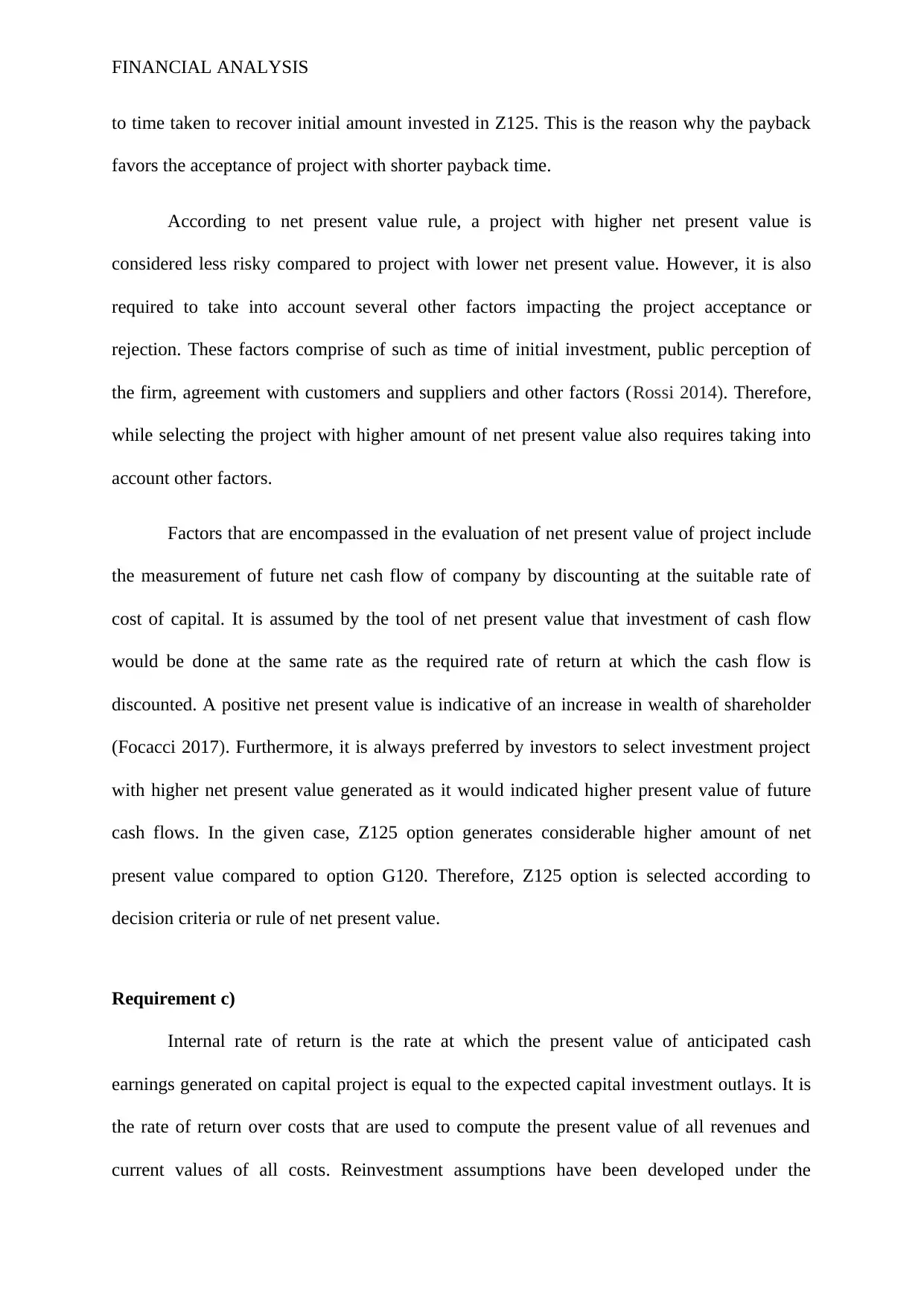
FINANCIAL ANALYSIS
to time taken to recover initial amount invested in Z125. This is the reason why the payback
favors the acceptance of project with shorter payback time.
According to net present value rule, a project with higher net present value is
considered less risky compared to project with lower net present value. However, it is also
required to take into account several other factors impacting the project acceptance or
rejection. These factors comprise of such as time of initial investment, public perception of
the firm, agreement with customers and suppliers and other factors (Rossi 2014). Therefore,
while selecting the project with higher amount of net present value also requires taking into
account other factors.
Factors that are encompassed in the evaluation of net present value of project include
the measurement of future net cash flow of company by discounting at the suitable rate of
cost of capital. It is assumed by the tool of net present value that investment of cash flow
would be done at the same rate as the required rate of return at which the cash flow is
discounted. A positive net present value is indicative of an increase in wealth of shareholder
(Focacci 2017). Furthermore, it is always preferred by investors to select investment project
with higher net present value generated as it would indicated higher present value of future
cash flows. In the given case, Z125 option generates considerable higher amount of net
present value compared to option G120. Therefore, Z125 option is selected according to
decision criteria or rule of net present value.
Requirement c)
Internal rate of return is the rate at which the present value of anticipated cash
earnings generated on capital project is equal to the expected capital investment outlays. It is
the rate of return over costs that are used to compute the present value of all revenues and
current values of all costs. Reinvestment assumptions have been developed under the
to time taken to recover initial amount invested in Z125. This is the reason why the payback
favors the acceptance of project with shorter payback time.
According to net present value rule, a project with higher net present value is
considered less risky compared to project with lower net present value. However, it is also
required to take into account several other factors impacting the project acceptance or
rejection. These factors comprise of such as time of initial investment, public perception of
the firm, agreement with customers and suppliers and other factors (Rossi 2014). Therefore,
while selecting the project with higher amount of net present value also requires taking into
account other factors.
Factors that are encompassed in the evaluation of net present value of project include
the measurement of future net cash flow of company by discounting at the suitable rate of
cost of capital. It is assumed by the tool of net present value that investment of cash flow
would be done at the same rate as the required rate of return at which the cash flow is
discounted. A positive net present value is indicative of an increase in wealth of shareholder
(Focacci 2017). Furthermore, it is always preferred by investors to select investment project
with higher net present value generated as it would indicated higher present value of future
cash flows. In the given case, Z125 option generates considerable higher amount of net
present value compared to option G120. Therefore, Z125 option is selected according to
decision criteria or rule of net present value.
Requirement c)
Internal rate of return is the rate at which the present value of anticipated cash
earnings generated on capital project is equal to the expected capital investment outlays. It is
the rate of return over costs that are used to compute the present value of all revenues and
current values of all costs. Reinvestment assumptions have been developed under the
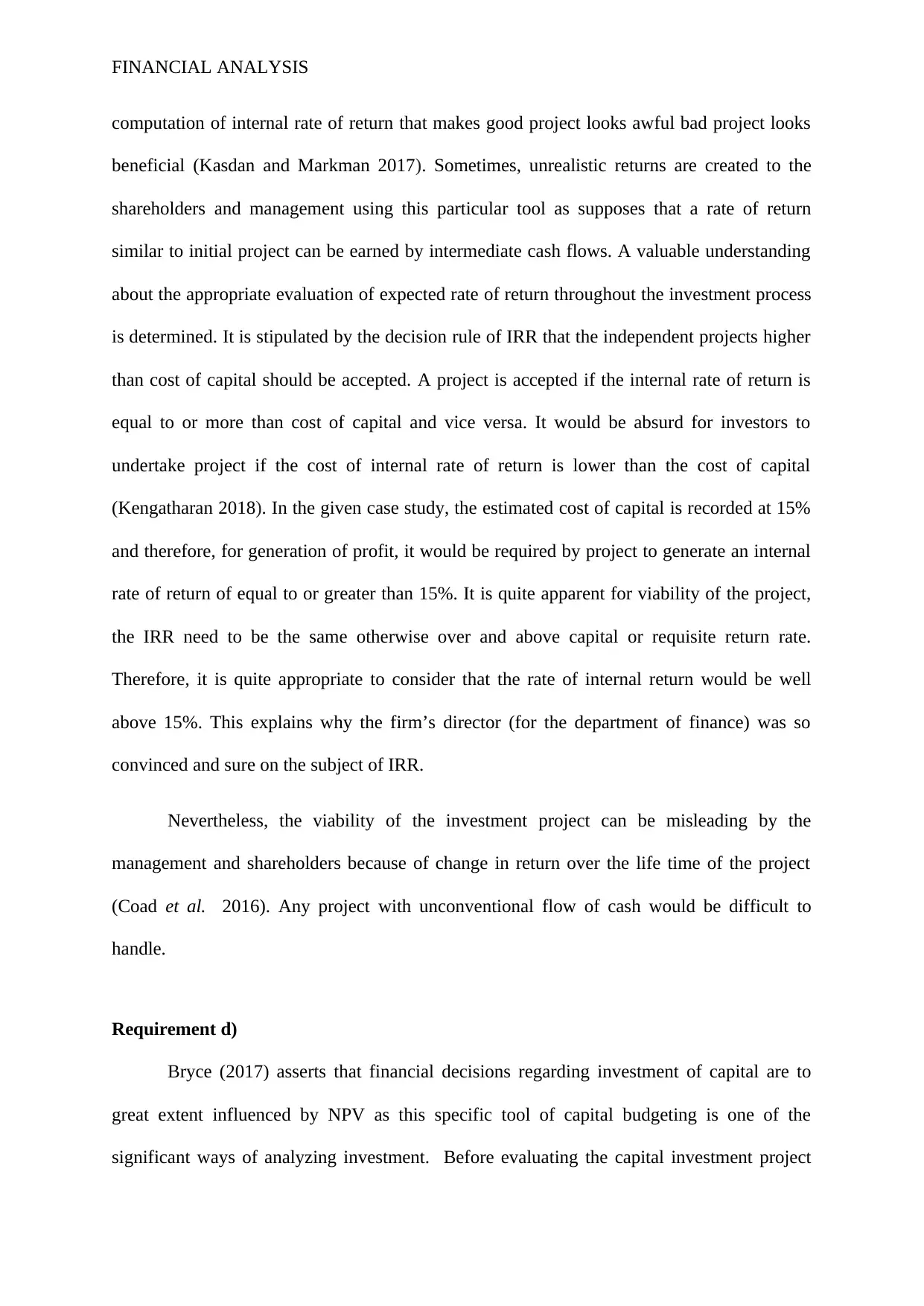
FINANCIAL ANALYSIS
computation of internal rate of return that makes good project looks awful bad project looks
beneficial (Kasdan and Markman 2017). Sometimes, unrealistic returns are created to the
shareholders and management using this particular tool as supposes that a rate of return
similar to initial project can be earned by intermediate cash flows. A valuable understanding
about the appropriate evaluation of expected rate of return throughout the investment process
is determined. It is stipulated by the decision rule of IRR that the independent projects higher
than cost of capital should be accepted. A project is accepted if the internal rate of return is
equal to or more than cost of capital and vice versa. It would be absurd for investors to
undertake project if the cost of internal rate of return is lower than the cost of capital
(Kengatharan 2018). In the given case study, the estimated cost of capital is recorded at 15%
and therefore, for generation of profit, it would be required by project to generate an internal
rate of return of equal to or greater than 15%. It is quite apparent for viability of the project,
the IRR need to be the same otherwise over and above capital or requisite return rate.
Therefore, it is quite appropriate to consider that the rate of internal return would be well
above 15%. This explains why the firm’s director (for the department of finance) was so
convinced and sure on the subject of IRR.
Nevertheless, the viability of the investment project can be misleading by the
management and shareholders because of change in return over the life time of the project
(Coad et al. 2016). Any project with unconventional flow of cash would be difficult to
handle.
Requirement d)
Bryce (2017) asserts that financial decisions regarding investment of capital are to
great extent influenced by NPV as this specific tool of capital budgeting is one of the
significant ways of analyzing investment. Before evaluating the capital investment project
computation of internal rate of return that makes good project looks awful bad project looks
beneficial (Kasdan and Markman 2017). Sometimes, unrealistic returns are created to the
shareholders and management using this particular tool as supposes that a rate of return
similar to initial project can be earned by intermediate cash flows. A valuable understanding
about the appropriate evaluation of expected rate of return throughout the investment process
is determined. It is stipulated by the decision rule of IRR that the independent projects higher
than cost of capital should be accepted. A project is accepted if the internal rate of return is
equal to or more than cost of capital and vice versa. It would be absurd for investors to
undertake project if the cost of internal rate of return is lower than the cost of capital
(Kengatharan 2018). In the given case study, the estimated cost of capital is recorded at 15%
and therefore, for generation of profit, it would be required by project to generate an internal
rate of return of equal to or greater than 15%. It is quite apparent for viability of the project,
the IRR need to be the same otherwise over and above capital or requisite return rate.
Therefore, it is quite appropriate to consider that the rate of internal return would be well
above 15%. This explains why the firm’s director (for the department of finance) was so
convinced and sure on the subject of IRR.
Nevertheless, the viability of the investment project can be misleading by the
management and shareholders because of change in return over the life time of the project
(Coad et al. 2016). Any project with unconventional flow of cash would be difficult to
handle.
Requirement d)
Bryce (2017) asserts that financial decisions regarding investment of capital are to
great extent influenced by NPV as this specific tool of capital budgeting is one of the
significant ways of analyzing investment. Before evaluating the capital investment project
⊘ This is a preview!⊘
Do you want full access?
Subscribe today to unlock all pages.

Trusted by 1+ million students worldwide
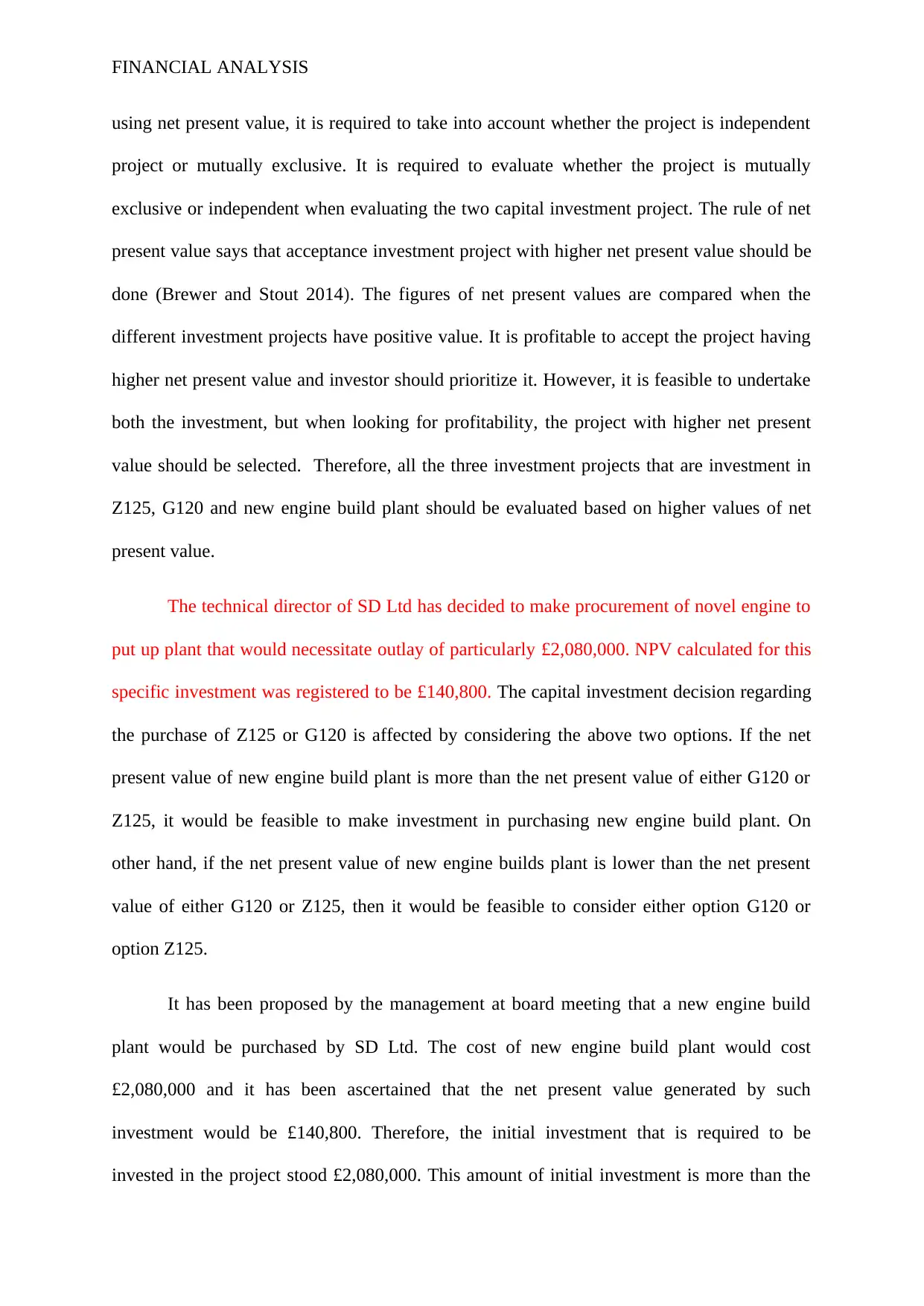
FINANCIAL ANALYSIS
using net present value, it is required to take into account whether the project is independent
project or mutually exclusive. It is required to evaluate whether the project is mutually
exclusive or independent when evaluating the two capital investment project. The rule of net
present value says that acceptance investment project with higher net present value should be
done (Brewer and Stout 2014). The figures of net present values are compared when the
different investment projects have positive value. It is profitable to accept the project having
higher net present value and investor should prioritize it. However, it is feasible to undertake
both the investment, but when looking for profitability, the project with higher net present
value should be selected. Therefore, all the three investment projects that are investment in
Z125, G120 and new engine build plant should be evaluated based on higher values of net
present value.
The technical director of SD Ltd has decided to make procurement of novel engine to
put up plant that would necessitate outlay of particularly £2,080,000. NPV calculated for this
specific investment was registered to be £140,800. The capital investment decision regarding
the purchase of Z125 or G120 is affected by considering the above two options. If the net
present value of new engine build plant is more than the net present value of either G120 or
Z125, it would be feasible to make investment in purchasing new engine build plant. On
other hand, if the net present value of new engine builds plant is lower than the net present
value of either G120 or Z125, then it would be feasible to consider either option G120 or
option Z125.
It has been proposed by the management at board meeting that a new engine build
plant would be purchased by SD Ltd. The cost of new engine build plant would cost
£2,080,000 and it has been ascertained that the net present value generated by such
investment would be £140,800. Therefore, the initial investment that is required to be
invested in the project stood £2,080,000. This amount of initial investment is more than the
using net present value, it is required to take into account whether the project is independent
project or mutually exclusive. It is required to evaluate whether the project is mutually
exclusive or independent when evaluating the two capital investment project. The rule of net
present value says that acceptance investment project with higher net present value should be
done (Brewer and Stout 2014). The figures of net present values are compared when the
different investment projects have positive value. It is profitable to accept the project having
higher net present value and investor should prioritize it. However, it is feasible to undertake
both the investment, but when looking for profitability, the project with higher net present
value should be selected. Therefore, all the three investment projects that are investment in
Z125, G120 and new engine build plant should be evaluated based on higher values of net
present value.
The technical director of SD Ltd has decided to make procurement of novel engine to
put up plant that would necessitate outlay of particularly £2,080,000. NPV calculated for this
specific investment was registered to be £140,800. The capital investment decision regarding
the purchase of Z125 or G120 is affected by considering the above two options. If the net
present value of new engine build plant is more than the net present value of either G120 or
Z125, it would be feasible to make investment in purchasing new engine build plant. On
other hand, if the net present value of new engine builds plant is lower than the net present
value of either G120 or Z125, then it would be feasible to consider either option G120 or
option Z125.
It has been proposed by the management at board meeting that a new engine build
plant would be purchased by SD Ltd. The cost of new engine build plant would cost
£2,080,000 and it has been ascertained that the net present value generated by such
investment would be £140,800. Therefore, the initial investment that is required to be
invested in the project stood £2,080,000. This amount of initial investment is more than the
Paraphrase This Document
Need a fresh take? Get an instant paraphrase of this document with our AI Paraphraser
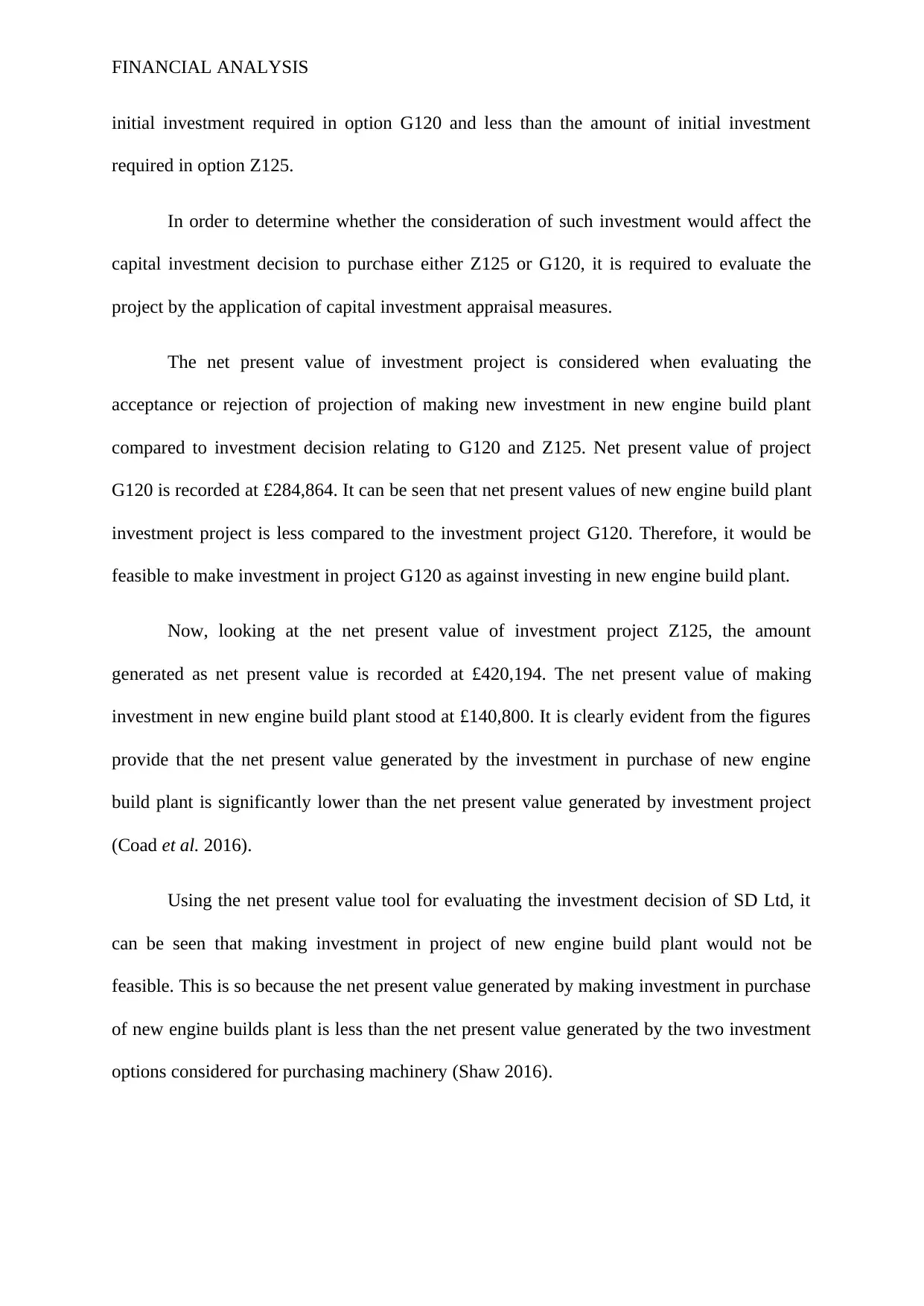
FINANCIAL ANALYSIS
initial investment required in option G120 and less than the amount of initial investment
required in option Z125.
In order to determine whether the consideration of such investment would affect the
capital investment decision to purchase either Z125 or G120, it is required to evaluate the
project by the application of capital investment appraisal measures.
The net present value of investment project is considered when evaluating the
acceptance or rejection of projection of making new investment in new engine build plant
compared to investment decision relating to G120 and Z125. Net present value of project
G120 is recorded at £284,864. It can be seen that net present values of new engine build plant
investment project is less compared to the investment project G120. Therefore, it would be
feasible to make investment in project G120 as against investing in new engine build plant.
Now, looking at the net present value of investment project Z125, the amount
generated as net present value is recorded at £420,194. The net present value of making
investment in new engine build plant stood at £140,800. It is clearly evident from the figures
provide that the net present value generated by the investment in purchase of new engine
build plant is significantly lower than the net present value generated by investment project
(Coad et al. 2016).
Using the net present value tool for evaluating the investment decision of SD Ltd, it
can be seen that making investment in project of new engine build plant would not be
feasible. This is so because the net present value generated by making investment in purchase
of new engine builds plant is less than the net present value generated by the two investment
options considered for purchasing machinery (Shaw 2016).
initial investment required in option G120 and less than the amount of initial investment
required in option Z125.
In order to determine whether the consideration of such investment would affect the
capital investment decision to purchase either Z125 or G120, it is required to evaluate the
project by the application of capital investment appraisal measures.
The net present value of investment project is considered when evaluating the
acceptance or rejection of projection of making new investment in new engine build plant
compared to investment decision relating to G120 and Z125. Net present value of project
G120 is recorded at £284,864. It can be seen that net present values of new engine build plant
investment project is less compared to the investment project G120. Therefore, it would be
feasible to make investment in project G120 as against investing in new engine build plant.
Now, looking at the net present value of investment project Z125, the amount
generated as net present value is recorded at £420,194. The net present value of making
investment in new engine build plant stood at £140,800. It is clearly evident from the figures
provide that the net present value generated by the investment in purchase of new engine
build plant is significantly lower than the net present value generated by investment project
(Coad et al. 2016).
Using the net present value tool for evaluating the investment decision of SD Ltd, it
can be seen that making investment in project of new engine build plant would not be
feasible. This is so because the net present value generated by making investment in purchase
of new engine builds plant is less than the net present value generated by the two investment
options considered for purchasing machinery (Shaw 2016).

FINANCIAL ANALYSIS
Conclusion:
From the analysis of two investment projects considered by SD Ltd using different
measures of capital investment appraisal, it can be concluded that making investment in
project A would be viable. As per rule of IRR and ARR, investing in G120 would be feasible.
Furthermore, the payback period of project G120 is less as against payback period of Z125.
Therefore, it would be viable for SD Ltd to make investment in project A that is G120.
Conclusion:
From the analysis of two investment projects considered by SD Ltd using different
measures of capital investment appraisal, it can be concluded that making investment in
project A would be viable. As per rule of IRR and ARR, investing in G120 would be feasible.
Furthermore, the payback period of project G120 is less as against payback period of Z125.
Therefore, it would be viable for SD Ltd to make investment in project A that is G120.
⊘ This is a preview!⊘
Do you want full access?
Subscribe today to unlock all pages.

Trusted by 1+ million students worldwide
1 out of 16
Related Documents
Your All-in-One AI-Powered Toolkit for Academic Success.
+13062052269
info@desklib.com
Available 24*7 on WhatsApp / Email
![[object Object]](/_next/static/media/star-bottom.7253800d.svg)
Unlock your academic potential
Copyright © 2020–2026 A2Z Services. All Rights Reserved. Developed and managed by ZUCOL.




